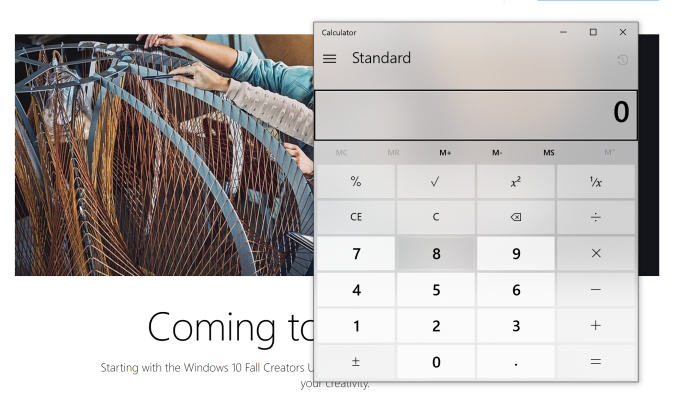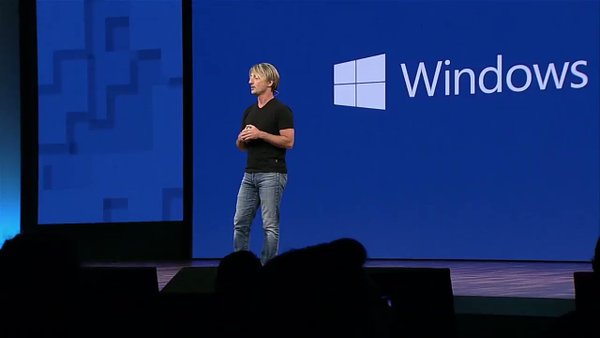The Windows 10 Fall Creators Update Feature Focus
by Brett Howse on November 10, 2017 8:00 AM ESTFluent Design
First announced at the Build 2017 developer’s conference, Fluent Design is the first major overhaul of the Windows 10 design and theme since Windows 10 washed away the remnants of Windows 8 back in 2015. Overall, the original design of Windows 10 has served it well, and it has been made clear after using it for the last several years that lessons were certainly learned from Windows 8, and those lessons were applied to Windows 10 to make a much more coherent and usable design language. But, as with anything, there’s always room for improvement, and the Redmond company is hoping that Fluent Design not only improves on the original, but keeps the UI and theming fresh.
Windows 10 runs on many different devices. The scalability of it is somewhat amazing, and after years of wanting to consolidate it’s OS efforts across device categories, it seems to have finally happened with Windows 10. But that brings some challenges as well, and as hardware has continued to evolve, we’ve started to see many different usage scenarios that traditional mouse and keyboard input would never work on. Touch, of course, is the most obvious and pervasive of these, and falls into the 2D category of input methods, along with keyboard and mouse, stylus, and more of the input methods we are used to. But we now live in a world with virtual reality, and augmented reality, both which live in the 3D space. There’s also 0D devices, such as the recently announced Cortana powered Harmon Kardon Invoke speaker and similar devices such as the Amazon Echo. IoT is becoming pervasive, and appears to be the next growth target in computing.
Fluent Design targets more than just 2D with five basic concepts: light, depth, motion, material, and scale. It may seems like a simple idea, but the key Fluent Design is that it will work well across different device types, but still be very useful on the traditional PC where Windows 10 still has its largest audience.
The move from Windows 7 to Windows 8 was pretty jarring, and the design language was very much flat and blocky. Windows 10 had already added some of the depth back in, but with Fluent Design they have also brought the essence of Windows 7 Aero back, along with new elements as well.
It’s tough to discuss Fluent Design without seeing it, because it’s not just a static idea. All of the elements tie in together to make the experience easier to navigate, more coherent, and more immersive. Check out this video that Microsoft created for their Dev Day:
Light is one of the key elements for selection, and this is doubly the case when you’re thinking of VR and AR technology, where a light gaze can be your pointer. Subtle highlights in lists give a stronger sense of where you are, and what you’re selecting.
Depth plays a big part too, and in the video you can see how going forward and backward in apps gives the feeling of going into an app or image, and then back out, connecting the experience of movement with where you are. This also plays into the motion, where you’ll see parallax scrolling and more.
Material selection is the transparency effects that will likely remind most people of Aero, but it is much more than just blurring. Instead of just background colors and blur, they will be doing multiple layers with Gaussian blur, exclusion blend, color and tint overlays, and tiled noise texture. The acrylic material can bring additional layering and depth to the app as well, but material is also able to be tied into scale, where if an app is in a windowed mode, it can have some blurring, but in a full-screen view, the blurring is eliminated to create focus on the one app.
Scale is likely the most underrated of them all, but Windows 10 is designed to work on everything from IoT to PC to Xbox to Surface Hub, so scale is critical to creating an app which will work across all of those form factors.
It’s hard to deny that Fluent Design is both form and function. There are design elements that are going to improve usability, but those same design elements also just look great. As we move forward, hopefully we’ll start to see more and more of this appear inside of Windows 10 and in the apps we use.
That’s really the only downside to Fluent Design right now though. There’s some of it sprinkled inside of Windows 10, and there’s work to be done to bring it more prominently to the forefront. The Action Center, for instance, has some elements of Fluent Design, but hovering over one of the notifications doesn’t bring any lighting effects to let you know you’re able to select it. Only some of the built-in apps have support right now. This will come over time, and likely even more slowly for third party apps, but it’s not here yet, at least not to its full extent.














95 Comments
View All Comments
Lunaria - Saturday, November 11, 2017 - link
This was the update that made me go back pre-creators update. I am done with them for now. It must be the first time they messed up DX so much, all because of some placebo game mode, some useless game bar and what the hell is that new feature that they added about cheaters gonna do? I sent them feedback about it, and pointed out how clunky it is, how much frame drops I am getting after it and how "disable fullscreen optimizations" or adding game mode toggle in the settings panel and then hiding that same toggle from us in this update is just terrific. They already messed up plenty of things. Sure your games alt tab faster in fullscreen exclusive mode... who cares if they don't run properly? I am on version 1151 build whatever, some February 2016 one. Immediately changed the update server IP so I do not get updates. Leave me alone. If they want to market gaming as a thing, they should go back to their origins and take their stable DX core, reduce latency even further, implement low profile recording with minimal impact and most importantly ask users if they want to use those features or even worse if it goes bad again, those "features". They improved it, yes, but it doesn't even come close to the smooth heaven that gaming before it was added was. Not to mention the creators tools that most people do not need. The Settings menu is getting populated slowly with useful and not so useful information, but it is nothing impressive and I doubt it will ever be. Microsoft if you get only 10 people to test your features, you will recieve better and more valuable feedback than pushing those things to users who will find a way to disable and not use them because you forced them to do so. Give us back what we love and don't Telemetry on us or force us to use Windows Defender, thank you.bill44 - Saturday, November 11, 2017 - link
Whatever happened to Windows 10 Color Management?WFCU supposed to bring in stage 2 improvements to color management, but looks like it's been left out.
Wide COlor Gamut support is useless without it.
Lunaria - Saturday, November 11, 2017 - link
Not to mention they reset my gamma settings all the time.Icehawk - Saturday, November 11, 2017 - link
Let me know when they figure out how to make W10 not bork a good % of my machines when upgrading, super annoying having to rollback and have wasted an hour.Lolimaster - Sunday, November 12, 2017 - link
Stick to win7 and maybe get a xbox one for those games that are win10 exclusives?Lolimaster - Sunday, November 12, 2017 - link
Nothing else justifies having win10 for productivity.marvdmartian - Monday, November 13, 2017 - link
No doubt! At least flash something up on the screen, letting me know that you're pushing an update, and installing it. That way, I'm not suddenly dealing with a crippled machine, that is spending so much of its resources installing a bunch of (mostly useless) "new & improved" apps, and wondering why it's not doing what I want it to do?At least you got a notification of updates, with previous versions of Windows. W10, you're not sure, until you finally get so frustrated, that you reboot....and only THEN get the "Please wait, installing updates" message.
My 2nd favorite part of W10, is the apps that they don't want you to uninstall....even if there's no chance in hell, that you will EVER use them! Because, who doesn't want a bunch of crapware, clogging up your OS, right??
Apple Worshipper - Sunday, November 12, 2017 - link
Windows sucked and will continue to do so. iOS is the undisputed future while iPads will be the one and only true form of mobile computing going. All others are not even worth speaking aboutMarburg U - Sunday, November 12, 2017 - link
And, as ALL the previous updates. This gives out the "interactive windows station" error, on half my computers. Another great job. Probably it will take me 4 days to reformat everything (AGAIN).Glock24 - Sunday, November 12, 2017 - link
Another change I noticed is that that air now using more of the "modern app" control panels. For example, when you right click the network icon and select "network and sharing center" you her one of those new control panels, which I personally dislike. The one good thing though is that it's now possible to set any network as "public" or "private" in the new network control panelAnother change I noticed is on the task manager. It now shows GPU usage and also shows multiple GPUs where it applies.
I've not seen any of the new "Fluent Design". Is that only for " modern apps"? If so I'll never see it, as I uninstall all of those as I find them very annoying.